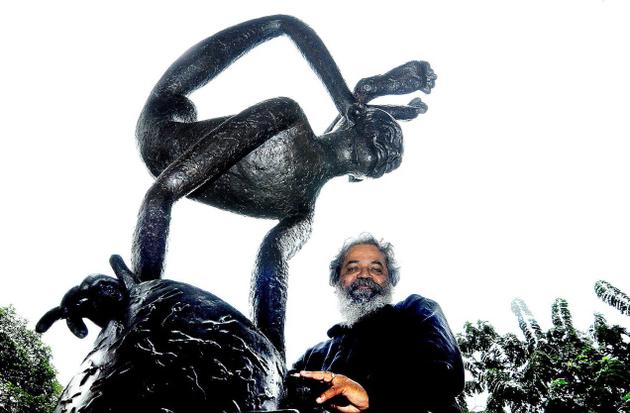The National Gallery of Modern Art presented a talk by the renowned sculptor K.S.Radhakrishnan on the 19th of December. As a class of ten, we entered the gallery and around us were trees and a vast architectural marvel – Manikyavelu Mansion. Next to the mansion were three black sculptures that we passed by. They seemed to be made of some kind of metal and looked similar to the pictures of ancient sculptures in our history textbooks. Depicting unhumanly flexible beings in positions that required skilful balancing, they had identical faces and were of a similar magnitude. The genitalia on the male sculptures didn’t hang down despite the challenging upside-down balancing acts they performed. We entered the hall and took our seats. The yellowish dim lighting provided a comfortable atmosphere for a siesta.
The speaker K.S.Radhakrishnan introduced himself. He was a man with a grey beard, a slight tan, glasses and a head full of hair. A Delhi – based, national award – winning Malayali sculptor, he began by speaking of his journey in the world of sculpture. He spoke about his first few sculptures and explained how far he had come. It was interesting to know how an Indian sculptor had travelled the world setting up sculptures.
 Sculpting as an art form has always interested me. Working with crafting M-seal and the process of modelling makes one feel like they can bring anything to life. A feeling that is hard to find while using other mediums. Maybe this is why the audience felt KS Radhhakrishnan and us.
Sculpting as an art form has always interested me. Working with crafting M-seal and the process of modelling makes one feel like they can bring anything to life. A feeling that is hard to find while using other mediums. Maybe this is why the audience felt KS Radhhakrishnan and us.
a slight connection with what K.S.Radhakrishnan said.
He then spoke about making public sculptures and how the demand for sculpture has changed. There are only a few people who buy sculptures. So if one is into making sculptures he/she can’t be in it for the money. When his latest work was presented, it was surprising because it turned out to be the same black sculptures that stood outside and caught everyone’s attention. K.S.Radhakrishnan explained the process of casting and how these metal marvels were made. (Casting is a manufacturing process in which a liquid material is usually poured into a mould which contains a hollow cavity of the desired shape, and then this is allowed to solidify. The solidified part is also known as a casting, which is ejected or broken out of the mould to complete the process.)
In the Q&A with the artist, a middle – aged man who sat on the right, with nostalgic feelings about Bengal, made a statement. “Of course you are influenced by Bengal”, he said, adding to a conversation that was taking place about the region. A woman on the right who seemed to take offence said in a booming voice “Any place can influence a person, it’s not just Bengal”. This was the most interesting point of the entire talk. The man stared at her for the rest of the Q&A session.
Latest posts by Ashwin Aravind (see all)
- Mapping with Figures: The Evolving Art of K.S. Radhakrishnan - 27th January 2016
- A sensational journey - 1st July 2015
- The art of living-things - 17th June 2015





